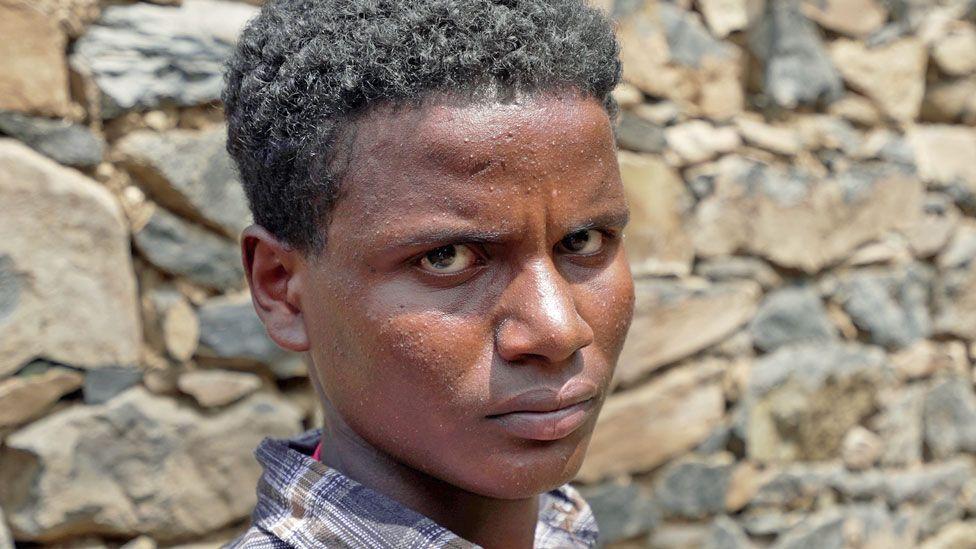In the tumultuous backdrop of Tigray, Ethiopia, the life of 16-year-old Berhane Haile changed dramatically one fateful day when he stepped on unexploded ordnance while walking home from school. This devastating incident resulted in severe injuries, including the amputation of his left leg and damage to his hands. Berhane recalls the horror of the explosion and the agonizing journey to the nearest hospital, which required him to be carried by his father and other villagers for two excruciating hours across hilly terrain. The remnants of war littering his village of Seyabo—a haunting reminder of the civil conflict that had engulfed the region—have left many like him vulnerable as they navigate a landscape filled with unseen dangers.
The civil war, which raged from late 2020 until a peace deal was reached in November 2022, resulted in an estimated half a million casualties. The conflict was fought between Ethiopian and Eritrean forces and local Tigrayan fighters, leading to a massive humanitarian crisis marked by displacement and a desperate need for aid. Although the fighting has ceased, the dangers remain ever-present in the form of unexploded munitions. Berhane was injured while diverting from his usual path to tend to his family’s livestock, highlighting the everyday risks that civilians face in post-war Tigray, as they navigate areas scarred by violence and neglect.
The long-lasting effects of the conflict are evident in the rising number of casualties caused by remnants of warfare. Since the beginning of 2023, the Red Cross has reported assisting nearly 400 individuals, predominantly children, injured by unintended explosions. However, this count is expected to be only a fraction of the true scale of the problem. Stories like that of Nigsti Gidey, who lost her husband to an explosion while working on a construction site, underscore the pervasive danger of unexploded ordnance and the psychological impact on surviving family members. Many locals have been urged to avoid touching metallic objects they encounter in their everyday lives, illustrating the profound mistrust and fear that now permeate their existence.
Despite the dreadful circumstances, local authorities and non-governmental organizations are stepping up efforts to address the issue of unexploded ordnance. In various villages, officials have begun conducting searches for these hazardous remnants. However, the process is hampered by limited resources, training, and manpower. For instance, police chief Hadush Gebremedhin is lobbying for more assistance to conduct thorough sweeps of affected areas, indicating the need for extensive coordination in dealing with the legacy of conflict. Currently, explosive remnants collected by local officers pose a potential risk as they are stored haphazardly, demonstrating the precarious situation faced by communities still recovering from the war’s aftermath.
As Tigray attempts to rebuild, basic services have started re-emerging, bringing a sense of normalcy. Berhane has returned to school, but the road to recovery has been challenging. The trauma of losing his eldest brother during the conflict and injuring his sister—a fighter who bears permanent disabilities—haunts him. While he is grateful to be alive, the loss of his dream to farm as he once did weighs heavily on his heart. With a prosthetic leg and the support of a humanitarian organization, Berhane now resides in Adwa with a sister as they navigate a new reality filled with uncertainty and dependency on aid.
Confronted with a drastically altered life, Berhane is determined to pursue his education despite the obstacles he faces. He has relocated to a town that allows him to attend school, albeit with the knowledge that the journey ahead will be arduous. His dreams of farming have been replaced by aspirations of becoming a civil servant, a shift that reflects his resilience and hope for a better future. However, the strain on his family continues, as they grapple with the long-term repercussions of the war even as they cling to the promise of recovery.
Amid the darkness that surrounds them, Berhane’s story embodies a broader narrative of survival and resilience in Tigray. His mixed emotions encapsulate the tension between grief and gratitude, as he navigates the complexities of a life reshaped by violence. Looking ahead, Berhane is committed to furthering his education and giving back to his family and community. His determination serves as a reminder of the enduring human spirit that persists even in the face of adversity—an essential beacon of hope for a region still trying to heal from the wounds of war.

